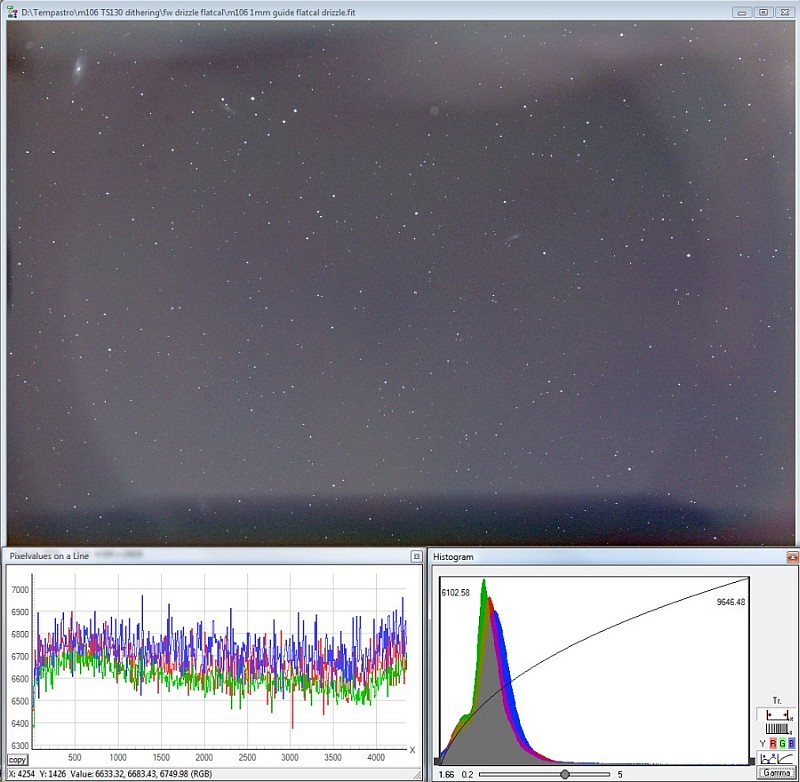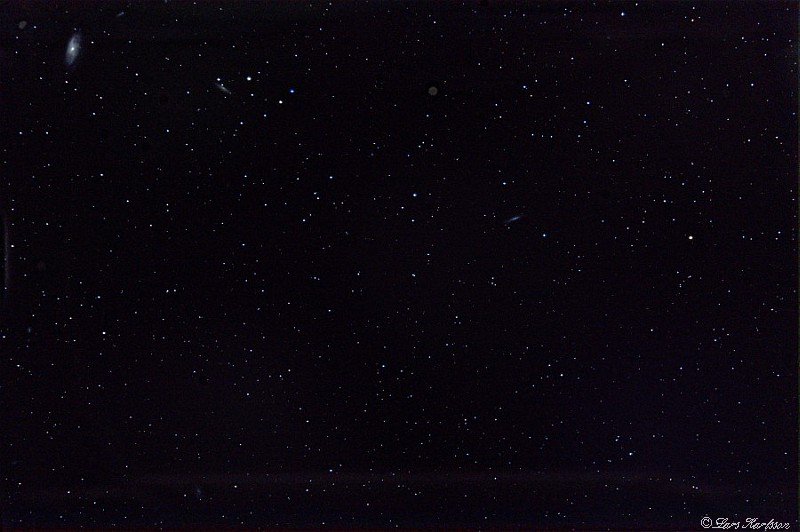|
Advertisement / Annons: |
My astronomy project:
|
Content:
Note: |
5: Vignetting analyzesDevoted time to take flats to calibrate the images. Used data monitor and a cardboard disc diffuser and sets the RGB color of the monitor so that the signal becomes 50% on all color channels of the camera in center (raw), that's the way I usually do. In the camera histogram window this level is on the right side, it will be so because the camera shows histogram with log scaling. The signal level must be checked with the appropriate program in the computer, I use Fitswork and rgb gain are set to = 1 for the RGB channels, it is important when doing analyzes to do like this. I did not succeed to remove all the dust on the sensor, and unfortunately it is not the dust when the currently used test image was taken. Has changed little on the mechanical adjustments since I took the picture I do test on here which is visible in the calibrated image. But curious as I'm I couldn't wait. 
As I keep on testing with different distances between field flattener and the sensor becomes easy to see that the different parts have rotated between trials. This is visible in the upper part of the image, how off-axis adapter ended up in a different angle and the flat calibration is therefore incorrect. This can be calibrated away with flats, but also believe that the prism to off-axis adapter can be pulled out a millimeter or two. When all this is finished it is important to secure the position of all the mechanics so it does not move and thus ruin the flat calibration. At the center of left edge there is a visible little darkening, it's the heel that stands out in the camera body that mirror resting on in folded down position. Strangely, not visible to the right, it seems as if the sensor is not centered to the middle of the optical axis which can be seen in other pictures too. For what reason? The darkening in the bottom in the picture is a real serious problem. The camera's mirror in the up position blocking parts of the lights. More or less such problems are for all DSLR cameras with full frame sensors. I have, however, contrast enhanced it significantly, it's also that my background light is 10 times higher here than it's on the countryside, hence that's why it stands out so clearly. There are also two concentric rings, that effect are from the adapters that are not wide enough. 
All together at this situation my useable sensor area isn't much larger than a APS-H sensor. I'm very happy with the off-axis adapter and the opportunities it offers so here I do not want to change too much. The telescope, I am also pleased with although it was very much clumsier than the 500mm f/4.5 lens I had before, but less than the 10" Newton. The camera I am pleased that there is a full frame sensor. But the house is so crowded in a DSLR as it causes such problems is not good. Solutions I must consider to get rid of vignetting problem:
1st
2nd
3rd A full frame sensor without mirror, like the Sony A7 series would otherwise be an ideal solution. Additionally 26mm more in back focus is attractive. But there will probably be many surprises and problems here too, what you see right away is that the bayonet entrance hole is too small, only 46mm. The latest I have read about Sony is that they do some ugly things to the raw files, very bad. (Update: The later Sony A7R II has much less compressed raw files). Alternatively, would surely be a monochrome CCD camera, but such a full frame sensor camera costs a lot of money, from 4000 Euro with filter wheels and then it's still a pretty simple sensor. On the whole, it feels that Kodak's old sensors are well antique today compared to what Sony accomplishes. Quite properly outside the budget too.
|
|